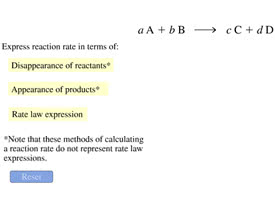1
answer
0
watching
275
views
18 Nov 2019
The rate of the reaction in terms of the "disappearance of reactant" includes the change in the concentration of the reactant, the time interval, and the coefficient of the reactant.
Consider the following reaction:
2A+3Bâ3C+2D
The concentrations of reactant A at three different time intervals are given. Use the following data to determine the average rate of reaction in terms of the disappearance of reactant A between time = 0 s and time = 20 s.
Time (s) 0 20 40 [A](M) 0.0200 0.0120 0.0090
Express your answer in molar concentration per second to three significant figures.
The rate of the reaction in terms of the "disappearance of reactant" includes the change in the concentration of the reactant, the time interval, and the coefficient of the reactant.
Consider the following reaction:
2A+3Bâ3C+2D
The concentrations of reactant A at three different time intervals are given. Use the following data to determine the average rate of reaction in terms of the disappearance of reactant A between time = 0 s and time = 20 s.
| Time (s) | 0 | 20 | 40 |
| [A](M) | 0.0200 | 0.0120 | 0.0090 |
Express your answer in molar concentration per second to three significant figures.
Irving HeathcoteLv2
9 Aug 2019

